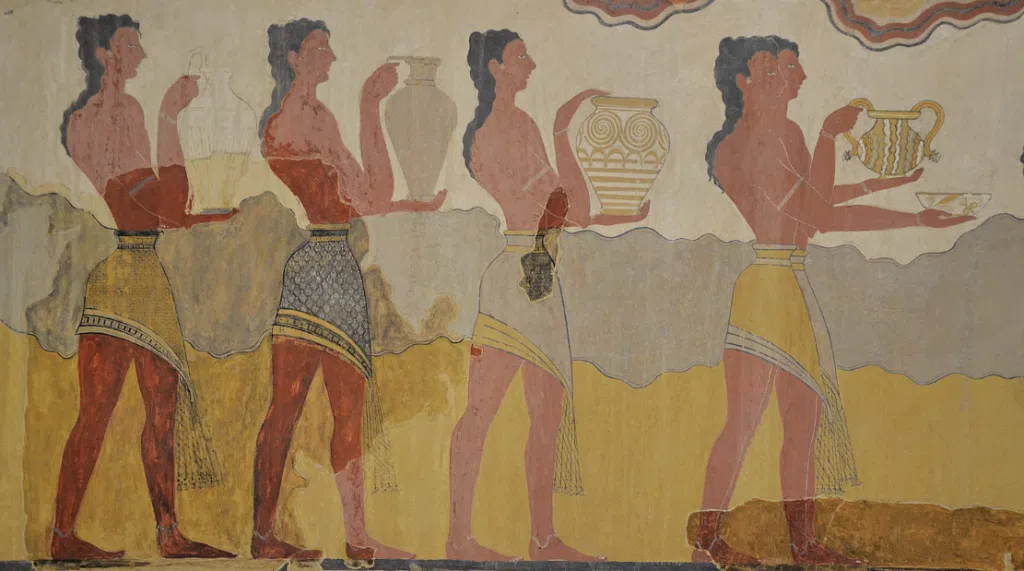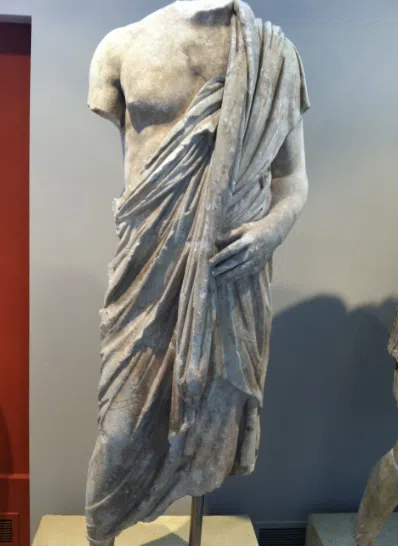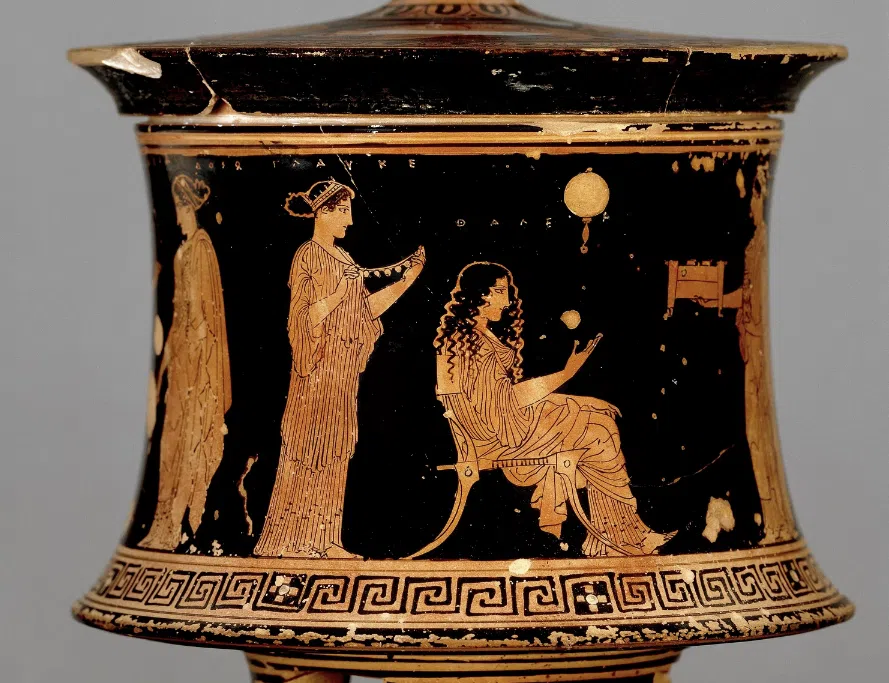
In the rugged and sunny shores of ancient Greece, where philosophy reshaped our world and democracy took its first baby steps, clothing played a fundamental role in defining people’s standing and personalities.
The clothes the early Greek men and women wore were a true artistic canvas, a statement of identity and proof of culture and social standing.
The ancient Greeks were known for their sophisticated sense of beauty and harmony, anyway. This is why they incorporated their values and ideals into the very fabrics they wore, turning them from objects of survival to statements of status.
From the flowing chiton to the draped himation, their attire was marked by a distinct simplicity that highlighted their profound significance in their lives. These garments, though seemingly straightforward and simple, were truly versatile symbols of class standing for their owners. They differentiated citizen from soldier, matron from maiden, and, most importantly, the wealthy from the common, ordinary folk.
Once someone digs a little deeper into this aspect of ancient Greek life that’s been a mere footnote in our history books, he or she can uncover the very textiles and trends that defined an entire era. Apart from that, however, we also get a deeper understanding of how clothing can reflect the various faces and levels of a society, regardless of the historical period we’re dealing with.
The history of Greek clothing is as rich and complex as the stories we’ve been hearing from this marvelous ancient civilization through their heroic tales and thrilling stories of mythology. From the intricate patterns of the Minoans to the Doric peoples of classical Athens, each piece of clothing reveals a crucial piece of information about ancient Greece and its people.
As archaeologists have discovered, the Greeks favored natural materials, with linen in particular covering the body in the hot Mediterranean summers and wool providing warmth in the cold and windy winters.
As trade networks from Greece to other places of the ancient world expanded over time, so too did the wardrobe of the affluent classes of Athens and the other major city-states of ancient Greece. With silk from distant lands becoming the ultimate display of wealthy status and opulence, rich Greeks explored new trends in fashion, experimenting with what was known thus far and pushing the boundaries of ancient fashion to new levels.
As we can understand, the evolution of Greek clothing was not just a matter of fashion but also a reflection of societal shifts. There, the austerity of Sparta, for example, contrasted with the embrace of opulence of cities like Corinth and Athens. In this constantly changing landscape of ancient fashion, the garments worn by people were a visual motif that described status, regional pride, and personal identity.

Materials and trends in ancient Greek fashion
For the upper ancient Greek class, the art of dressing was a way of projecting elegance as well as functionality. The chiton and peplos, which were primary garments of this era, draped over the body of everyone, regardless of their city-state. These types of clothing embodied the Greek ideals of symmetry and harmony alike.
Men typically wore the famous chiton to their knees. This was a symbol of their role in the public and other martial aspects of their life. In contrast, the garments of women flowed all the way to their ankles. This was a reflection of their revered status within the domestic life, projecting modesty and ethos.
The himation and chlamys, on the other hand, served as versatile outerwear for the Greeks. They offered warmth and stature, with their folds capturing the ethereal beauty that we now associate with ancient Greek style so much. Materials, obviously, played a crucial role in all of this.
With linen used by Greeks in the summer and wool offering protection against the chill of the winter months, these were the two main materials used most commonly.
Silk was a rare luxury. It was used by the very few to narrate tales of wealth and status, with its sheen being proof of the wearer’s social importance. For the ancient Greeks, the length of a garment and the choice of fabric spoke volumes about their place in society, to a much greater extent than it does now.

Color, patterns, and accessories in ancient Greek fashion
The color palette of ancient Greek fashion was a vibrant reflection of their rich mythology. Colors were not just different shades but also a language of status, allegiance to a specific group, and personal character. The deep blues and radiant reds that adorned their clothes were as much a part of their identity as the stories of gods and heroes that shaped their culture.
Patterns, too, were very important when it came to the differentiation of their wardrobe. The Greek key motif, also known as meander, for example, symbolized unity and was a symbol of the continuity of life and beauty of Greek elegance.
Accessories were also important parts of Greek attire. Each piece was a reflection of the taste and status of theiwearer. Jewelry, ranging from simple earrings to extravagant bracelets, glittered in the Mediterranean sun and showcased intricate designs. These were often inspired by the natural world and the rich mythological stories of the Greeks.
Headbands and hairpins also served practical purposes, of course, but were indeed symbols of grace and beauty as well. These accessories, coupled with the rich variety of colors and patterns, completed the ancient Greek style.
Accessories in ancient Greek fashion
As one can understand, clothing was more than a shield against the elements for the ancient Greeks. It was a mirror that reflected the many layers of identity and social status. The garments one wore were a silent way of showing their place in the world. It was a dialogue between the individual and the rest of the community that spoke of profession and even city-state allegiance.
The distinction between the austere military style of Sparta and the refined elegance of Athens was not just a matter of aesthetics. It was deeply emblematic of the divergent values as well as lifestyles that characterized these two archrival city-states. Additionally, the cultural significance of nudity, especially in athletic competitions, reveals a lot about a society that celebrates the human form without any taboos. Thus, nudity was seen as a matter of beauty and strength rather than an element of embarrassment.
The cultural dimension of ancient Greek fashion
After studying ancient Greek clothing, one can see the elements of an ancient civilization and its power of expression through mere clothes. The garments of ancient Greece, with their simplistic and yet harmonious elegance, remind us that clothing style has always been a universal language. The fashion of ancient Greece teaches us that what we wear is a reflection of both our personal journey and the collective understanding of the beauty of our times. It is timeless proof of the human desire to express and connect with each other.
See all the latest news from Greece and the world at Greekreporter.com. Contact our newsroom to report an update or send your story, photos and videos. Follow GR on Google News and subscribe here to our daily email!



